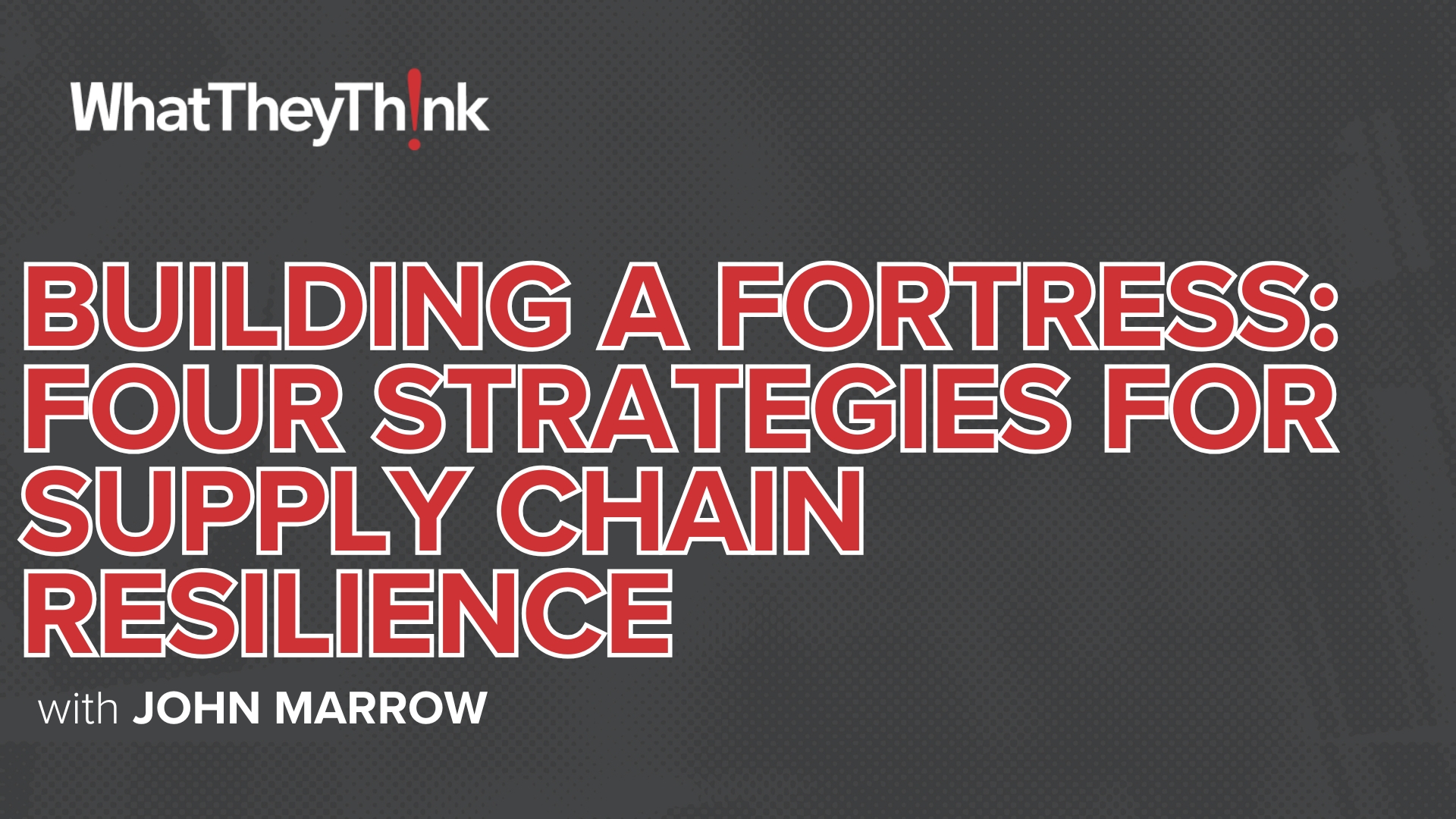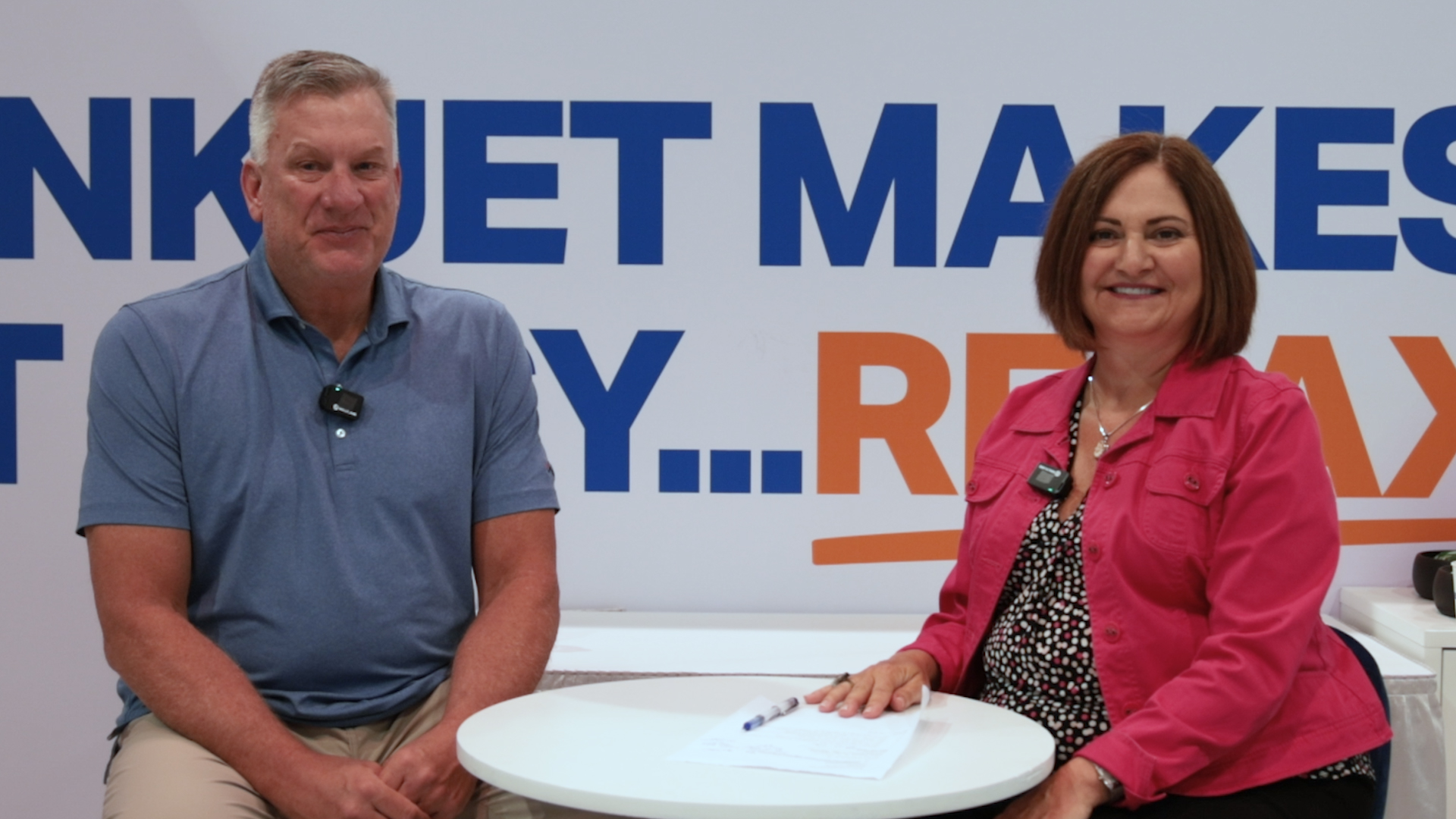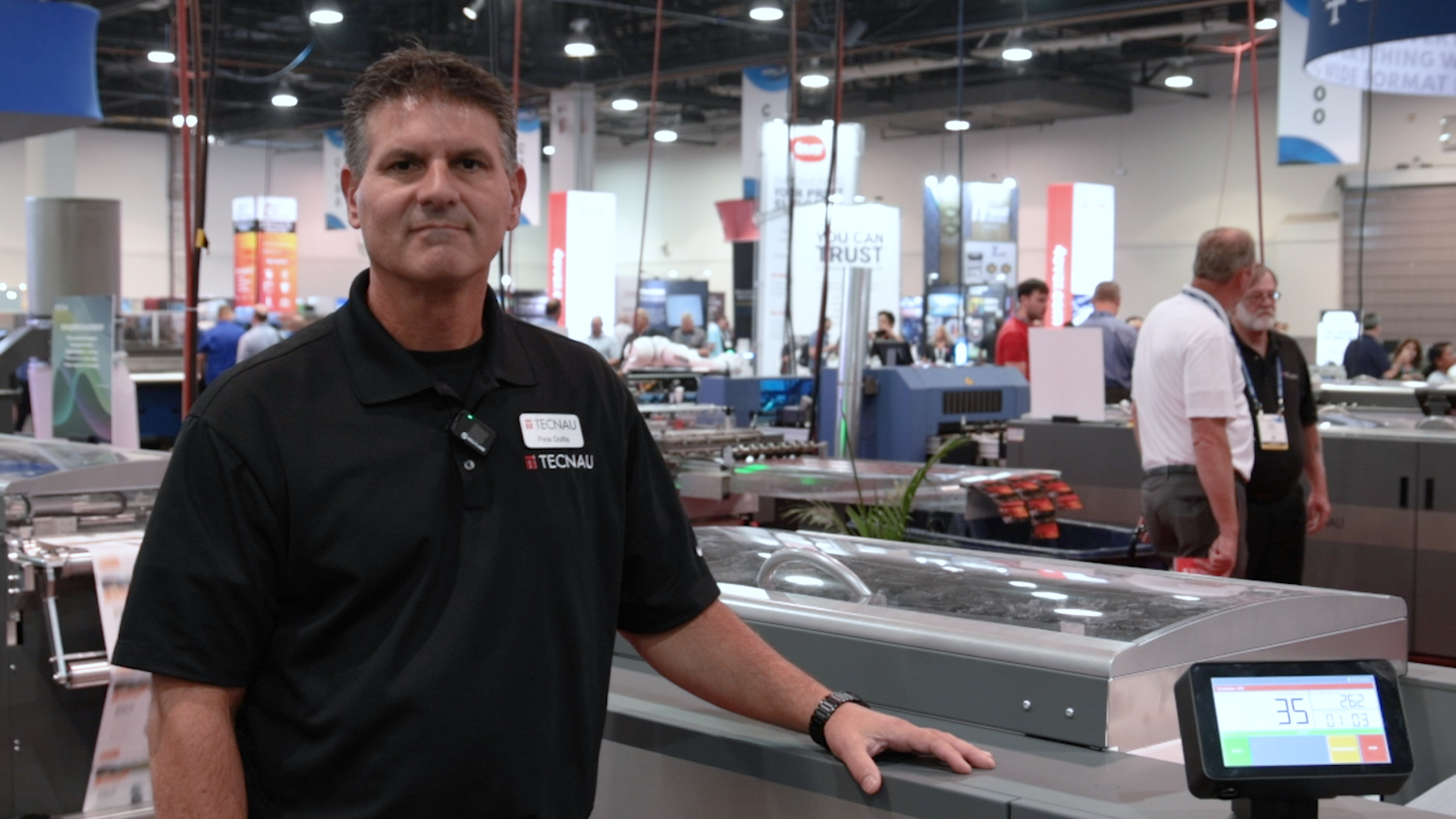Commentary & Analysis
Displaying 751-850 of thousands of articles
Insight You Need. Analysis You Trust.
Get the trusted insights you need to understand our evolving industry and emerging trends. Become a Premium Member.
Turnover and Employment in Print in Europe—Austria
This bi-weekly series of short articles aims at shedding a spotlight on the size of the printing industry in Europe per country and how revenues and employment developed in 2020, when the pandemic impacted businesses. This time we look at Austria, the tenth-largest printing industry by turnover in Europe.
The Artificial-ness of Generative AI
Have you tried ChatGPT, Bard, or another generative AI technology? They use algorithms to respond to prompts, leveraging available data pools to provide responses. They can be taught to respond to almost anything that can be broken down into steps. And they can make mistakes. Are you ready?
Kyocera’s Expanding Footprint
Kyocera’s intention is clear: they are moving into the production print industry, and while they may be new to selling inkjet presses in this market, they have 30 years of expertise in developing ink and material jetting solutions, and an impressive track record at that. In this article, sponsored by Kyocera, David Zwang looks at their recent initiatives.
Getting to Carbon ZERO
A recent Axios newsletter was headlined “No safe port in a climate storm.” In this article, Senior Editor Cary Sherburne looks at some of the recent extreme events attributed to climate change, as well as greenwashing, greenwishing, and greenhushing, more buzzwords for your vocabulary. She highlights some of the projects that are underway to reduce greenhouse gas emissions on the way to getting to Carbon ZERO…a state we are not likely to reach for some time, but progress, however slow, is being made.
Around the Web: Fresh Font. Colonial Currency. Timeless Textiles. Cool Calendar. Food Fossils. Mennonite Machines. Hammock Hanger. Scream Search. Movie Mashup. Cake Crash.
Microsoft 365 has a new default typeface. Benjamin Franklin vs. counterfeiters. A Japanese textiles company still uses 40-year-old software. A wall-mounted E Ink-based calendar that syncs with Google Calendar. A new museum exhibit focuses on “food archaeology.” Electric bikes are popular among…the Amish? A fast-deploying portable hammock. The original “Wilhelm scream” has been found. Opening today: “Barbenheimer.” Hostess introduces the Ding Dongs x Twinkies Mashup. All that and more in WhatTheyThink’s weekly miscellany.
Sanitary Paper Product Manufacturing Establishments—2010–2020
According to County Business Patterns, in 2020 there were 123 establishments in NAICS 322291 (Sanitary Paper Product Manufacturing). This category saw a net decrease in establishments of -13% since 2010. In macro news, new business applications continue to rise.
Marketing in the Age of Data Overload
Data analytics is essential in modern marketing. It enables marketers to make more informed decisions about their strategies by providing valuable insights into customer demographics, interests, and behaviors. As marketers intensify their efforts, they must remain mindful of today’s staggering volumes of data. This article explores the challenges that direct marketers face with data management and how they can address them.
There Is No Turning Back: ITMA 2023 Marked a Significant Turning Point For Textile Innovation, AI, and Creativity
This article, complements of textiles expert and WhatTheyThink contributor Debbie McKeegan and the Pixel to Parcel blog, reports that ITMA 2023 in Milan marked a significant turning point for textile innovation, AI, and creativity. In fact, this article was created using AI, with search terms recycling, fashion, and environmental! It covers the need for the textiles and apparel industry to step up its action on reducing its environmental footprint and preparing for an onslaught of regulatory changes over the next few years. Read on!
How Hard Do You Look at Your Talent?
Contributor Wayne Lynn explains in depth how to evaluate how your business is performing by creating a “composite” client and building a situation where a company has declining performance driven mostly by issues with customers and salespeople. The body of this article is a memo written to the owner of this hypothetical client.
ESG Practices: More Than Just Another Acronym?
Contributor Heidi Tolliver-Walker looks at Environmental, Social, and Governance (ESG) practices—a set of criteria that measure a company’s performance and impact on critical environmental, social, and ethical issues—and how they apply to print businesses.
The Production Inkjet Evolution: Canon Continuous Feed
In 2011, I began a series that looked at the then-current production inkjet vendor product offerings, and over the years continued to look at how they were being, or could be, used. In this new series, 15 years later and with drupa 2024 on the horizon, it’s time to take a look at how production inkjet has evolved, how it is used, and where we can expect it to go and grow. I will look at each of the production inkjet manufacturers and suppliers, customers and document some of their journeys. In this article, I look at the journey of the Canon continuous-feed line.
Ink, Sustainability, and Regulatory Challenges
A raft of legislation under the European Green Deal has been, or is planned to be, implemented by the EU to make society more sustainable. The activity with the biggest impact on the printing and packaging industry is the Packaging & Packaging Waste regulation. European section editor Ralf Schlözer looks at the issues involved in and potential impacts of these new laws.
Scratching the Itch of Customer Engagement: Reimagining a Decades-Old Solution to Boost Event Experiences
Contributor Joanne Gore looks at how a decades-old print application—scratch-off cards—are being used in combination with interactive technologies to create more immersive experiences for trade shows and other events.
Around the Web: Keyboard Carousing. Perishing Paper. Hammer Happiness. Album Art. Calming Canines. Automotive Aviation. Fungus Funeral. Auteur Adventure. Condiment Collection.
Milwaukee’s inaugural QWERTYFEST celebrates the invention of the typewriter. The world’s oldest national newspaper has produced its final print edition after 320 years. “People are paying to break printers with sledgehammers in smash rooms.” Graphene-based “e-skin.” Aqualamb brings back album art in the age of streaming. Noise-canceling headphones for dogs. The flying car is almost here! Italian automotive hackers create the lowest drivable car, for some reason. Mushroom-based coffins for the burgeoning “green burial” trend. Enter “Tim Burton’s Labyrinth.” Burger King’s “real cheeseburger.” All that and more in WhatTheyThink’s weekly miscellany.
June Printing Production Employment Up Slightly, Non-Production Down
Overall printing employment in June 2023 was down -0.2% from March. Production employment was up 0.4% while non-production employment was down -0.6%.
Meeting Ever-Shorter Turnaround Demands in the Wide Format Market
The ever-increasing demand for immediate delivery is creating some unique challenges for today’s print service providers (PSPs). Wide-format print jobs have become especially challenging because they often require a great deal of customization, personalization, and design modifications. This article discusses some top strategies that can help PSPs to manage the turnaround expectations of today’s print buyers.
Want Pixel-Perfect Prints? Make Color Management a Priority
In a digital world, many expect color management to be an exact science, a simple and automatic function of the print process—simply place your on-demand order, and voila—your print arrives on time and just as you imagined it. But unfortunately, that’s far from true. In this article, complements of textiles expert and WhatTheyThink contributor Debbie McKeegan and the Pixel to Parcel blog, color management—and how to get it right, first time, every time—are explained.
ICYMI: Printers Share Their Workflow Automation Success Stories
Patrick Henry takes a deep dive into the myriad ways print businesses are implementing workflow automation, the tools they are using, and the results they have achieved. The range of what printers have accomplished indicates how much becomes possible once a plant commits to workflow automation.
Eurolabel Embraces GEW ArcLED Technology in Transition to UV LED
GEW’s latest customer case study explores why Eurolabel, a successful label printing company on the outskirts of Milan, embraced GEW ArcLED. Eurolabel employs almost 80 employees and an annual turnover of around €12 million. Learn why they embraced GEW’s ArcLED technology.
Want to Improve Productivity? Increase Employee Engagement
According to Gallup, 59% of employees are “quiet quitting” and 18% are “loud quitting,” or fully disengaged. The result? Low productivity, poor performance, and high risk of turnover. Fortunately, there are some simple things employers can do to re-engage employees and turn things around.
Turnover and Employment in Print in Europe—Finland
This bi-weekly series of short articles aims at shedding a spotlight on the size of the printing industry in Europe per country and how revenues and employment developed in 2020, when the pandemic impacted businesses. This time we look at Finland, the 14th largest printing industry by turnover in Europe and the second largest in the Nordic region.
Social Profiles Are Forever
Estate planning, succession planning, and getting our affairs in order are part of life. If you run a business, the process of planning for the next generation or next owner is part of the process. In our personal lives, we tend to look at the big things to make sure assets are identified and that there is a plan for how they will be handled in the future. We’re talking about what happens when someone dies, whether it is anticipated or unexpected. Here are some things to add to your list.
Executive Q&A: Kyocera’s Jose Maria Estebanez
WhatTheyThink European Section Editor Ralf Schlözer talks with Jose Maria Estebanez, Vice President of Corporate Marketing for Kyocera, about the company’s first production inkjet press, the TASKalfa Pro 15000c.
The Target Report: Stick to Your Knitting—June 2023 M&A Activity
Lakeside Acquires Marquis, and more…
Accurate Printing of Color-Critical Materials Essential to Printing Success
Since the early days of digital color printing, color management has been a struggle for many. And some struggle even in the analog world. Although the presses have improved, including significant color management automation, it can still be difficult to get everything right, especially when it is necessary to exactly match color across multiple press types—analog and digital—as well as to ensure good color representation in digital files often used during the proofing cycle. We spoke with Meredith Nichols, a certified color management and workflow automation consultant, and a member of the Color Management Group, about how she works with clients and why certifications are important.
Other Converted Paper Product Manufacturing Establishments—2010–2020
According to County Business Patterns, in 2020 there were 483 establishments in NAICS 32229 (Other Converted Paper Product Manufacturing). This category saw a net decrease in establishments of -20% since 2010. In macro news, BEA revises Q1 GDP up.
Around the Web: Clever Katherine. Magazine Massacre. Cool Curtains. Lens Literature. Lawn Loathing. Canine Conflagration. Barbie Buildings. Beverage Bling.
The only woman’s name that appears on the Declaration of Independence. National Geographic lays off its last remaining staff writers. Turn your walls or windows into huge, animated Lite-Brites. The Sol Reader is essentially a Kindle embedded in a pair of glasses. Making “smart paper” with liquid metal. A graphene-based wearable and wireless patch that detects signs of liver inflammation. A design firm’s war against…lawns. The new face of terror: a robotic dog with a flamethrower attached to its back. Barbie’s Dream House in each state. Is a 2,000-year-old Pompeiian fresco the oldest depiction of a pizza? 7-Eleven introduces Slurpee-themed jewelry, for some reason. All that and more in WhatTheyThink’s weekly miscellany.
ICYMI: Wrapper’s Delight: High School Senior Wins Bus Wrap Design Contest
For the last three years, Laketran in Lake County, Ohio, has held a student Design-a-Bus Wrap contest, sponsored by Avery Dennison. This year’s winner was Mentor High School senior Kaitlin Barninger. Richard Romano looks at how this year’s winning design came about.
Digital Certification for the Textile Printer—Latest Developments: The EU Digital Passport and Reborn
Green-washing, green-wishing, and any terminology in between no longer washes. Consumers are becoming more aware of the damage the textile industry does to the planet. The industry must quickly reevaluate the fashion supply chain. Ethically conscious consumers evaluate their purchase decisions around the sustainability and traceability of the manufactured product. To evaluate the integrity of these products, the consumer must rely on the quality of the certification provided to reinforce their choice. Gone are the days when buzz words like “eco-friendly,” “organic,” and “sustainable” will suffice. See how the EU Digital Product Passport may help in this article compliments of textiles expert and WhatTheyThink contributor Debbie McKeegan.
Product Spotlight: Getting Product Personalization Right with LiveArt
Consumers are no longer satisfied with only buying mass-produced products. Online and brick-and-mortar print shops have offered B2B and B2C buyers the ability to customize printed products, but the process is sometimes complex and hard to understand. Pat McGrew looks at LiveArt’s web-to-print services which address the gap between off-the-shelf web-to-print solutions available in the market and the growing needs of printers requiring more custom-tailored solutions for their clients.
At Wise, Lean Is Not Just “A” Strategy for the Business; It’s “The” Strategy
Want more productivity, higher levels of efficiency, and greater profitability? Automation is one way to get there, but lean is, too. In this Q&A, Bill Prettyman, CEO of Wise, discusses why lean is no longer a strategy for the business. It’s become the strategy for the business.
LeadingPRINT Summit Looked at All Aspects of Print Industry Leadership
APTech’s LeadingPRINT Summit, held June 14 and 15 at the Westin O’Hare in Rosemont, Ill., featured two days of formal presentations and informal discussions of the biggest challenges facing the industry and how to address them. The event was capped off by a tour of Morton Grove, Ill.’s Quantum Group. This article recaps the event.
Gallus’ Expandable Ecosystem Designed for Future Growth
The previously announced Gallus One digital label press is more than just an “all in one” label press, jointly developed by Gallus and Heidelberg. It is at the core of an expandable ecosystem designed for the industry’s digital future and the new normal.
Why Consider Professional Services for Your Mission Critical Projects?
The temptation is always there. How hard can it be to handle a new project, an assessment, a business plan, or strategy development on your own? Why pay a consultant or another organization to come in and do work that you know you and your team can do? Clearly it will be less expensive to handle the requirements between the production work, maintenance, and client care! Or, is it? Let’s investigate!
When Automation Revolutionizes Your Business
The significant investments Documation has made in workflow and finishing equipment has completely revolutionized its business. Jeremy Stanek, Documation’s Vice President of Operations, explains.
Intergraf’s Print Matters for the Future Conference 2023 Looks at Industry Megatrends
Print Matters is an annual conference, organized by Intergraf, the European association of the national print associations, and the Nordic Printing Association NOPA. The 2023 conference took place in Riga, Latvia, and focuses on some of the most pressing issues of the European printing industry. European section editor Ralf Schlözer runs down the highlights of the presentations.
April Shipments Maintain Seasonality—Just as We Feared
April 2023 printing shipments came in at $7.00 billion, down from March’s $7.58 billion and in line with annual seasonality—although it is a bit below the previous two Aprils.
Around the Web: Bewildering Bots. Commemorating Kafka. Mac Merch. Paper Peeping. Analog Attraction. Freed Feline. Netflix Noshing. Planet Pondering. Tamer Tippling.
A “public service videogame” that invites players to verify images incorrectly to confuse bots. Type designer and typographer Oded Ezer’s unique “The Samsa Enigma” project for the 140th anniversary of Franz Kafka’s birth. A knitted blanket based on the original Mac OS desktop. Behind the scenes at Seven Days, a Vermont-based weekly newspaper. The continuing resurgence of non-digital technologies. A kitten is rescued from a packaging recycling container. Converting a pickup truck into a giant dot matrix printer. Could life exist on Venus, of all places? When out at the bar, be sure to adjust for drinkflation.” All that and more in WhatTheyThink’s weekly miscellany.
All Hail the Power of Print: Digital Textile Innovations Abound at ITMA, Milan 2023
All hail the power of print, for ITMA didn’t disappoint. Packed with innovations at all levels, the show proved to be an incredible success. Visitor numbers reached 111,000 from an impressive 143 countries, and exhibitors peaked at 1,709 spread across an incredible 200,000 square meters of exhibition space. The venue was well organized, easy to reach, and well-serviced; and for those that exhibited and those that visited, was credited as a truly successful experience. Textiles expert and WhatTheyThink contributor Debbie McKeegan shares her perspective.
Paper Maintains Its Appeal Among General Office Workers
Even in the digital age, paper remains essential for many office workers. This article cites recent research from Keypoint Intelligence to illuminate how today’s office workers are interacting with paper. It also explores paper’s particular appeal among younger office employees.
The Darker Side of AI: It’s Up to Us to Avoid It
For our industry, AI offers up a powerful tool for things like workflow connectivity, analytics, and shop floor data analysis, as well as development of marketing content. But there are legitimate fears around AI, as well. When it comes to addressing those fears, it remains an individual effort.
Gamechanger and Online Print Booster: 30 Years of PDF
From the World Wide Web to cloud services, technological developments in recent decades have fundamentally changed industry and business—and with them the work and processes in print shops. However, one small tool, or rather file format, is often overlooked in the list, even though data exchange in general and online printing in particular would not work as we know it today. We’re talking about PDF, the Portable Document Format, which turns 30 this year—and has been with me for just as long. Time to talk about its history and its importance to printing.
Epson Brings New Capabilities, Functionality to North American Direct-to-Garment Printing
Epson has long been a leader in direct-to-garment printing. With the launch of the new SureColor F2270 to the North American market, Epson is bringing its third generation of this popular affordable mid-level direct-to-garment (DTG) platform to market with a number of enhancements that benefit quality and productivity, and have sustainability characteristics as well. We spoke with Epson’s Senior Product Manager, Tim Check, to learn more.
Building a Performance-Based Culture Starts with Better Hiring Decisions
This is the fourth in a series of five articles addressing the need for significant efforts to improve productivity to offset a shrinking and increasingly expensive labor market. The purpose of the article was to develop an understanding of how involved and time consuming the CEO/owner should plan for in leading this effort. In the last article, I provided a long list of recommendations for the reader’s consideration. I concluded that one specific example would be a good way to get the point across. Read on, I hope you enjoy!
Stationery Product Manufacturing Establishments—2010–2020
According to County Business Patterns, in 2020 there were 324 establishments in NAICS 32223 (Stationery Product Manufacturing). This category saw a net decrease in establishments of -35% since 2010. In macro news, the US birth rate increased insignificantly in 2022—the latest in a worrying demographic trend.
Around the Web: Robust Reference. Antiquated AI. Funny Features. Nose Knowing. Minstrel Manuscript. Diamond Dwarf. Rising Robot. Cheese Chasing. Toy Trouble. Peanut Party.
The World Book is the last remaining printed encyclopedia. ChatGPT running on 1980s era computer technology. Satirical UI features in popular apps. “At no point is the child’s nose actually removed from the child’s face. [citation needed]” Graphene-based eco-denim. An ancient manuscript is actually a medieval stand-up comedy routine. A star is turning into a giant diamond. A robot vacuum that can climb stairs. Entering a robot dog in dog show. A woman is knocked unconscious while chasing a giant cheese down a hill. Supreme Court shoots down parody products. The Planters NUTmobile to become “the Nuttiest Dive Bar.” All that and more in WhatTheyThink’s weekly miscellany.
Finding a Happy Medium Between Greenwashing and Greenhushing
Consumers want to do business with firms that share their concern for the environment, but being accused of greenwashing is almost as bad as having no sustainability goals at all. As a result, some businesses are now engaging in “greenhushing,” which involves deliberately downplaying any environmental commitments. This article discusses the importance of striking a balance between the two extremes.
Stepping Into Digital Textile Printing: Why Now Is the Right Time To Jump In
This guest article written by Jos Notermans of SGPrints, and brought to you compliments of textiles expert and WhatTheyThink contributor Debbie McKeegan, dives into some of the objections or concerns of textile printers who have not yet stepped into the digital world, and explains why they should be making the move to digital, sooner rather than later.
Turnover and Employment in Print in Europe—Czechia
This bi-weekly series of short articles aims at shedding a spotlight on the size of the printing industry in Europe per country and how revenues and employment developed in 2020, when the pandemic impacted businesses. This time we look at Czechia (also called Czech Republic), the eleventh-largest printing industry by turnover in Europe and the second largest in Central and Eastern Europe.
Print Volume Trends in Sheetfed and Continuous Feed Inkjet
Three weeks ago, as part of WhatTheyThink’s fourth annual Technology Outlook Week, our five-day series of webinars that look at the latest trends and technologies in a broad cross-section of the industry, Ralf Schlözer took a look at digital printing. In part two of her coverage of this session, Heidi Tolliver-Walker sums up the discussion of print volumes.
ICYMI: Zen and the Art of Software Maintenance
At its essence, software is a tool that is based in science, but has artistic manifestations. The style of coding, the elegance of programming expression, and the user interfaces that join the user to the software capabilities create a yin/yang relationship. Software does require care and feed, however. Here is some guidance on living with software, whether it was created in your shop, downloaded for free, or purchased from a vendor!
The Production Inkjet Evolution: Canon Production Cut-Sheet Inkjet
In 2011, I began a series that looked at the then-current production inkjet vendor product offerings, and over the years continued to look at how they were being, or could be, used. In this new series, 15 years later and with drupa 2024 on the horizon, it’s time to take a look at how production inkjet has evolved, how it is used, and where we can expect it to go and grow. I will look at each of the production inkjet manufacturers and suppliers and customers and document some of their journeys. In this article, I look at Canon cut-sheet production inkjet.
Here Come the Robots—News and Trends from FESPA 2023
The FESPA Global Print Expo was held in Münich, Germany, May 23 to 26. WhatTheyThink European section editor Ralf Schlözer attended and identifies some highlights from the show.
ITMA 2023: The Highlights
ITMA, the International Textile Machinery Association, opened the doors for its quadrennial show in Milan, running from June 8 to 14. Owned by CEMATEX and organized by ITMA, this edition is focused on “Transforming the World of Textiles.” For those of you in the printing industry who may not be familiar with ITMA, it’s the drupa of the textiles industry. In this article, we present some of the show highlights as of this writing. Stay tuned for more!
Tech Outlook: Finishing Roundup
Last month, as part of WhatTheyThink’s fourth annual Technology Outlook Week, our five-day series of webinars that look at the latest trends and technologies in a broad cross-section of the industry, Trish Witkowski and Kevin Abergel looked at the latest products, technologies, and trends in binding and finishing. In this article, Heidi Tolliver-Walker recaps the webinar.
Johnson’s World—You Have Mail…Or Maybe Not
By law, the US Postal Service is supposed to deliver mail six days a week. Steve Johnson tries to understand why his mail delivery has become erratic and unreliable.
Printing Pulse: Embellishment Edition
This edition of our Friday data series offers a preliminary “sneak peek” at the results of the Taktiful and WhatTheyThink 2023 Specialty Digital Ink and Toner Embellishment Study. This study takes a deep dive into how current users of digital ink and toner embellishment technologies are utilizing them, what the response from customers has been, how satisfied print providers have been with the sales and profitability of these jobs, where the challenges lie, and their general feelings about the future of digital ink and toner embellishment technologies.
Around the Web: Ledger Lines. Typewriter Tunes. Graphene Garments. Pink Paucity. Plate Problem. Sadistic Subscriptions. Block Clock. Panel Panic. Baneful Bot.
A look at how they used to print ledger books. The Boston Typewriter Orchestra performs on NPR’s Tiny Desk Concert. Absolut is introducing lightweight paper-based bottles for its vodka. Another leap forward for graphene-based wearable textiles. The “Barbie” movie caused a shortage of pink paint. Some Maryland license plates contain a link to a Philippine gambling site. Thanks to the “aaS” model, we don’t really own anything anymore. A solar-powered mechanical LEGO clock that will keep time for a billion years. The time has come to address the imminent deluge of discarded solar panels. Can experts really judge wine? A pop-up Cheez-It filling station in Joshua Tree National Park. All that and more in WhatTheyThink’s weekly miscellany.
The Target Report: The Party is Over at Vice Media, and Why it Matters—May 2023 M&A Activity
Vice Media Files Bankruptcy, and more …
What’s Old Is New Again: Will Paper Really Replace Film in Flexible Packaging? The Future Borrows from the Past for Some Exciting New Ideas
With the increased scrutiny of plastic use in flexible packaging, there is an increased interest in moving from plastic to paper. It was once hard to make the switch, but it has been getting much easier.
Razzle Dazzle: User Success Stories on Creating Memorable Tactile Experiences
Taktiful’s Kevin Abergel talks to three US print service providers that have successfully won over customers after installing digital embellishment production systems.
Solutum Offers a New Approach to Reducing Plastic Waste
Solutum is a Cleantech company on a mission to reduce plastic pollution by providing sustainable alternatives to single-use plastic. The company has created a revolutionary compound that can be engineered to create a range of flexible packaging with versatile end-of-life options. Cary Sherburne talks to Sharon Barak, the company’s Founder and CTO, to learn more about this innovative approach to solving the plastics problem.
Kyocera FOREARTH Digital Textile Printer Debuts at ITMA
Kyocera printheads are popular components in many digital textile printing systems. Now, Kyocera has applied that knowledge and expertise to its first digital textile printer, FOREARTH, making its first public appearance at ITMA in Milan. In this interview, Sho Taniguchi, Kyocera’s Deputy General Manager, IDP Business DevelopmentDivision, explains the strategy behind development of this system and why they believe it is beneficial to the textiles market.
You’ve Got Mail: Mailing Technology Continues to Revolutionize Direct-Mail Marketing
Today’s mail technology enables campaigns that are truly cutting edge, and that edge is getting sharper. We’ve barely scratched the surface of what can be done with personalized, customized messaging printed on the outside of the envelopes. Heidi-Tolliver Walker takes a look at the current state of the art.
Is There a Robot in Your Future?
Levi’s turns 170 this year, but it’s not letting its age get in the way of its innovation. The company reports that it has allocated 25,000 hours to a team of in-house robots over the past year. These robots, though, are not replacing employees. Rather, they are making work more efficient and enjoyable by freeing employees from performing a number of often repetitive and tedious tasks, and making more time for them to focus on more strategic activities. And Levi’s isn’t alone in harnessing the power of robots to make work more efficient. Here’s a quick pre-ITMA view of robotics in textiles, with more to certainly come from the world’s largest textile industry trade show, this week in Milan.
Tech Outlook: Packaging
Two weeks ago, as part of WhatTheyThink’s fourth annual Technology Outlook Week, our five-day series of webinars that look at the latest trends and technologies in a broad cross-section of the industry, David Zwang took a look at labels and packaging. In this article, Heidi Tolliver-Walker recaps the webinar.
Crawl, Walk, Run—Enter the Embellishment World at Your Own Pace
Trish Witkowski takes a deep dive into the hardware available for adding embellishments, be they analog or digital. She runs down the top technologies, and identifies specific equipment at the entry level, mid-range, and high end of the market for each technology.
Artful Adaptations: Matt Redbear Is No Stranger to Changing Technology and How to Use It to His Advantage
WhatTheyThink Multimedia Production Editor Jessica Taylor profiles Matt Redbear, creative director for Taktiful, and talks about how he used AI to come up with the cover for the most recent (Issue 3) print edition of WhatTheyThink.
The Whole Package: How to Turn a Product into a Purchase by Appealing to a Consumer’s Senses
David Zwang provides a primer on embellishment technologies for packaging applications—including why they are becoming more important than ever for brands.
Tech Outlook: A Framework for Automation
Two weeks ago, as part of WhatTheyThink’s fourth annual Technology Outlook Week, our five-day series of webinars that look at the latest trends and technologies in a broad cross-section of the industry, Pat McGrew and Ryan McAbee took a look at software and workflow—specifically addressing automation. In this article, Heidi Tolliver-Walker recaps the webinar.
The Rise of Sexy Print: Digital Embellishments Are Revolutionizing Ink on Paper, Creating New Opportunities for Marketers and Brands
Digital embellishments allow brands to create visually stunning packaging and labels, with intricate designs otherwise difficult or impossible to achieve affordably with traditional printing methods. Joanne Gore looks at the current lay of the land.
Talkin’ ’Bout My Generation
The USPS conducted the “Generational Research Report,” which shows who’s reading what and what elements of direct mail are most important to which generations. Think of it as that generation’s direct mail fingerprint. Heidi Tolliver-Walker offers some highlights.
From Display Graphics to Graphic Tees: Already Print Soft Signage? Why Not Add Garment Printing?
As commercial printers, in-plants, and sign and display graphics printers look for ways to expand their businesses and offer new products and services to their customers, expansion into the textiles industry looks like an interesting opportunity. Cary Sherburne explains how.
Technology Outlook: Digital Printing
Two weeks ago, as part of WhatTheyThink’s fourth annual Technology Outlook Week, our five-day series of webinars that look at the latest trends and technologies in a broad cross-section of the industry, Ralf Schlözer took a look at digital printing. In this article, Heidi Tolliver-Walker recaps the webinar.
Paperboard Container Shipments Back up to Pandemic Levels
In March 2023, the value of shipments of paperboard containers was $6.361 billion, the highest it has been since August 2022.
Around the Web: Creative Contents. Letterpress Love. Pedestrian Pals. Creepy Closure. Lighthouse Living. Graphene Gaming. Skin Solution. Winging Weight. Hellish Hammer.
Experimental tables of contents. 105-year-old Bay View Printing still prints on century-old letterpress equipment. LA’s “crosswalk vigilantes” help improve pedestrian safety. “Séance AI” for one last chat with the departed. The US Government is auctioning off lighthouses—some for free. Artificial “e-skin” can communicate with the brain. An Indian food inspector drains a reservoir to retrieve his phone. New Zealand Air to start weighing passengers for “data collection purposes.” The “Hammer Fist” is a bizarre tool. Plastic wine bottles are on their way. All that and more in WhatTheyThink’s weekly miscellany.
ICYMI: FESPA 2023 Review: New Tech, Trends, and Key Market Shifts—A Powerful and Successful Show for the Global Print Community
From DTG & DTF to screen printing and from digital inks to consumables, the scope of innovation was evident to all attendees who showed great interest in the 70+ new product launches at FESPA. In this article, textiles expert and WhatTheyThink contributor Debbie McKeegan offers some highlights of the most notable unveilings that took place at this global show.
Technology Outlook: Wide Format and Signage
Last week, as part of WhatTheyThink’s fourth annual Technology Outlook Week, our five-day series of webinars that look at the latest trends and technologies in a broad cross-section of the industry, Richard Romano and Cary Sherburne tag-teamed a look at wide-format and signage and textiles and apparel. This article recaps the wide-format portion of the webinar
“Soon to Be Unveiled” Functionality Will Let Printers Integrate Directly with Salesforce, HubSpot, and Other Marketing Automation Platforms
One of the missing pieces in print marketing automation has been the ability for printers to integrate with their customers through platforms like Salesforce, HubSpot, and Zapier. Heidi Tolliver-Walker teases a forthcoming solution that will allow printers and clients to work together directly.
Productivity Improvement Options
This article is the third in the series on how to incorporate productivity improvement into your growth strategies for the foreseeable future. What approaches to improvement should you consider? This article has a list of five general groupings of ideas and recommendations. Hopefully, it will prompt the reader to generate even more. Building on a long-running theme, we continue to emphasize that improving the personal effectiveness of employees and improving business productivity overlap and work together. Half of the ideas listed touch on various aspects of what that entails.
Fighting Deforestation by Tracking Print
The European Union is introducing a regulation on deforestation-free products as part of the European Green Deal. European section editor Ralf Schlözer digs into what the new rules mean for printers.
AI Is Here! Fire Everybody?
Welcome to the rise of the robots—or at least chatbots! Businesses in every segment are looking at how artificial intelligence can help them grow. The anecdotes are becoming part of the mainstream—eliminating staff positions and replacing them with chatbots is a common theme. That begs the question: what happens if you fire everybody and let the bots do the work? Let’s explore that.
Paper Bag and Coated and Treated Paper Manufacturing Establishments—2010–2020
According to County Business Patterns, in 2020 there were 723 establishments in NAICS 32222 (Paper Bag and Coated and Treated Paper Manufacturing). This category saw a net decrease in establishments of -12% since 2010. In macro news, the Architecture Billings Index suggests a recovery from the slowdown in the construction industry.
Around the Web: Hefty Hitchhikers. Code Cooling. Dot Displays. Wedding Wear. Graphene Griddle. New Nova. Ring Removal. Cat Commerce. Custom Ketchup.
A special print edition of The Hitchhikers Guide to the Galaxy five-book trilogy is on the way. QR codes just aren’t cool any more, a least in restaurants. William A. Lavalette, an obscure 19th-century Black inventor, received two printing press-related patents. Louisville, Ky.’s American Printing House for the Blind museum expands and is reimaged as The Dot Experience. A biodegradable wedding dress made from the roots of wheatgrass. The first graphene-based kitchen appliance. A star in Ursa Major just went supernova. New research suggests that Saturn’s rings won’t last forever. CatVana is Carvana—but for cats. Heinz has a new mixer for customized ketchup. All that and more in WhatTheyThink’s weekly miscellany.
In-Plants: Maintaining Relevance in an Evolving Industry
In early 2023, Keypoint Intelligence partnered with Ricoh Corporation to conduct an in-depth survey of 50 in-plant respondents and a series of one-on-one interviews. This article provides a brief overview of our research findings to shed some light on the challenges that today’s in-plants are facing and strategies for future growth.
What Will It Take to Rewire The Fashion System? An Interview with Simon Platts of RE-UP
Simon Platts, CEO and Co-founder at RE-UP, has been a fashion industry practitioner for more than three decades and has the knowledge, experience and industry insight to successfully navigate change. In this article, compliments of textiles expert and WhatTheyThink contributor Debbie McKeegan, she and Simon discuss the systemic change required in the fashion industry and how it could be changed at warp speed through collaboration, transparency, and knowledge transfer.
Take Advantage of the Rapidly Growing Textile Dye-Sub Market with the Durst P5 TEX iSUB
In this article, sponsored and written by Durst, learn about the Durst P5 TEX iSUB dye-sublimation printer. With a 3.3m width, the P5 TEX iSUB can print direct-to-fabric as well as on transfer papers, and offers Dual- and Multi-roll options.
Focus on AI: Creating Sales and Marketing Copy for Email Marketing
Heidi Tolliver-Walker talks with Josh Bluman, co-founder of Hoppy Copy, an AI copywriting platform that focuses on creating sales and marketing copy for email, social media, and newsletters.
Production Inkjet Evolution: HP Preprint Corrugated
In 2011, I began a series that looked at the then-current production inkjet vendor product offerings, and over the years continued to look at how they were being, or could be, used. In this new series, 15 years later and with drupa 2024 on the horizon, it’s time to take a look at how production inkjet has evolved, how it is used, and where we can expect it to go and grow. I will look at each of the production inkjet manufacturers and suppliers, customers and document some of their journeys. In this article I look at HP preprint corrugated.
Looking Out for Print at Interpack 2023
European section editor Ralf Schlözer reports from Interpack, held May 4–10 in Düsseldorf, Germany. Interpack focuses on technologies and materials for filling, packaging, and packaging printing.
Museum of Printing: An Industry Gem
Did you know that one of the world’s most expansive museums of printing is located in Haverhill, Mass.? If you don’t know about this industry gem, we hope this brief overview will spark your interest in visiting the museum, and even more importantly, donating to ensure its longevity! I was fascinated during my recent visit, and truly, we only scratched the surface of what the museum has to offer.
Around the Web: Writing Racket. Typewriter Tour. Dutch Design. Automated Arms. Digital Dog. Swarm Struggle. Radio Removal. Prince Pavement. New Nova? Truffle Trouble.
A self-digitizing pen…you have to subscribe to. A realistic animated tour inside a mechanical typewriter. A conductive elastic ink that can 3D print more flexible wearable devices. When in Amsterdam, be sure to get a Rembrandt tattoo. Researchers have developed wearable robot arms. Spin Master’s Bitzee hopes to be the next Tamagotchi. A swarm of bees prevented a Delta flight from taking off. AM radios are disappearing from cars. Prince is getting a Minnesota highway named after him. Is Betelgeuse about to go nova? Oscar Mayer’s “Wienermobile” is now the “Frankmobile,” and you can see the jokes coming a mile away. Mac and cheese truffles. All that and more in WhatTheyThink’s weekly miscellany.
April Printing Production Employment Down Slightly, Non-Production Up
Overall printing employment in April 2023 was down -0.2% from March. Production employment was down -0.8% while non-production employment was up 1.1%.
Dye Sublimation Digital Print 2023 Review Q1: Part 2—Sublimation Inks and Transfer Papers
Dye sublimation continues to grow in popularity as a digital fabric printing technology. Critical to the quality of the print are the inks and transfer papers. In this article, textiles expert and WhatTheyThink contributor Debbie McKeegan reviews both.
Print Services Helps CHRISTUS Health Fulfill Its Mission
CHRISTUS Health Print Services, the in-plant printing department for the CHRISTUS Health network of ministries and hospitals, took a tentative step into producing wayfinding signage—and has since proven itself essential to fulfilling CHRISTUS Health’s mission of serving its community.
Seven Trends in the “Future of Work” and What They Might Mean for the Printing Industry
Recently, Fast Company interviewed Karin Kimbrough, LinkedIn’s chief economist, to tap into her insights about the future of work drawn from more than 930 million members and 63 million companies on the LinkedIn platform. Here we look at Fast Company’s seven takeaways from a conversation it co-hosted at the recent RSA Conference and what they might mean for the printing industry.
Setting Appropriate Productivity Goals
In his last article Wayne Lynn talked about the fundamentals of measuring your company’s productivity. In this post, he uses that discussion to talk about setting smart, appropriate goals for improving productivity in your firm. Wayne also starts the conversation around how you meet your new goals. Read on…
Where Do You Get Your Print Industry Learning?
We hear from printing companies that they have trouble finding new staff that are already trained and ready-to-go. We hear from vendors that they have the same problem. It isn’t a new problem! It has been with us for decades, but the problem grew as we emerged from pandemic restrictions. Not only is it hard to hire experienced people, but it is hard to train people inside your four walls because many subject matter experts are either overwhelmed with their jobs or they are plotting their retirement. Let’s talk about paths to an educated workforce.
Production Inkjet Evolution: Kodak
In 2011, I began a series that looked at the then-current production inkjet vendor product offerings, and over the years continued to look at how they were being, or could be, used. In this new series, 15 years later and with drupa 2024 on the horizon, it’s time to take a look at how production inkjet has evolved, how it is used, and where we can expect it to go and grow. I will look at each of the production inkjet manufacturers and suppliers, customers and document some of their journeys. In this article I look at Kodak.
Turnover and Employment in Print in Europe—Poland
This bi-weekly series of short articles aims at shedding a spotlight on the size of the printing industry in Europe per country and how revenues and employment developed in 2020, when the pandemic impacted businesses. This time we look at Poland, the sixth-largest printing industry by turnover in Europe and the largest in Central and Eastern Europe.
- Questions to ask about inkjet for corrugated packaging
- Can Chinese OEMs challenge Western manufacturers?
- The #1 Question When Selling Inkjet
- Integrator perspective on Konica Minolta printheads
- Surfing the Waves of Inkjet
- Kyocera Nixka talks inkjet integration trends
- B2B Customer Tours
- Keeping Inkjet Tickled Pink
© 2024 WhatTheyThink. All Rights Reserved.














